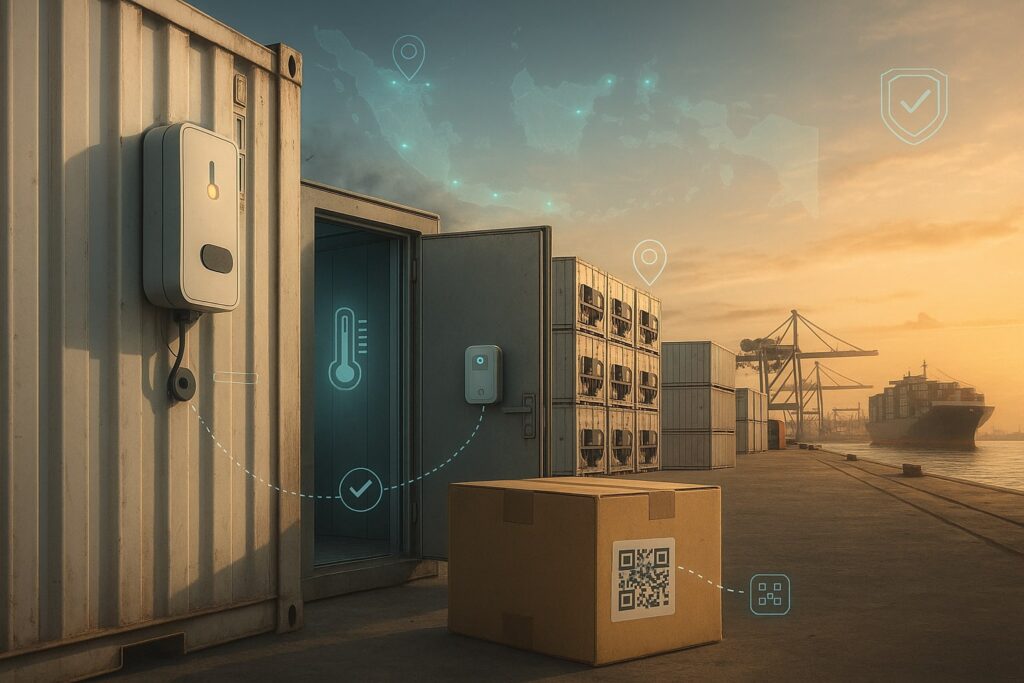A freshly inked pact to wire Indonesia’s cold chain with AI-enabled sensors is more than an infrastructure story. If built on open standards, it could be the archipelago’s compliance on-ramp for the FDA’s traceability rule, Europe’s deforestation law and retail’s shift to 2D barcodes—while cutting post-harvest losses and unlocking cheaper finance.
On 22 September 2025, South Korea’s Willog and Indonesia’s cold-chain industry group ICCA/ARPI announced a memorandum of understanding to roll out AIoT “K-logistics” monitoring across the country’s temperature-controlled network—reefers, rooms and routes. The release talks of modernising the sector and aligning with Jakarta’s National Logistics Ecosystem goals. That is the headline. The subtext is bigger: a national data backbone that can generate auditable, machine-readable evidence for export buyers and regulators.
Indonesia’s geography makes such a backbone unusually valuable. The world’s largest archipelago—17,000-plus islands—has long struggled with logistics costs that are high by regional standards. Recent government and donor analyses put logistics costs around 14.29% of GDP, with a stated objective to push them toward single digits over the next two decades. A cold chain that doesn’t just chill but proves it did so—capturing time, temperature and hand-offs in a format buyers can trust—goes straight to competitiveness.
Table of Contents
ToggleFrom telemetry to evidence
The temptation, with sensor networks, is to celebrate dashboards. The more consequential shift is standardised traceability. Two regulatory clocks explain why.
First, the U.S. FDA’s Food Traceability Rule (FSMA 204). In August the agency proposed a 30-month compliance extension to 20 July 2028, but the data architecture—Critical Tracking Events and Key Data Elements—is settled. Industry guidance now assumes the GS1 EPCIS 2.0 event standard and related identifiers (GTIN for products, GLN for locations) as the lingua franca for exchanging those records. If Indonesia’s cold-chain telemetry is EPCIS-native from day one, it will be consumable by U.S. buyers without custom plumbing.
Second, the EU Deforestation Regulation (EUDR). After last year’s political wrangling, application dates are fixed for 30 December 2025 (large operators and traders) and 30 June 2026 (micro and small firms). For coffee, cocoa and rubber this means plot-level geolocation plus due-diligence attestations. While most horticulture won’t fall under EUDR, the same rails that move cold-chain events can carry origin and risk data alongside.
A third, commercial clock is ticking too: “Sunrise 2027.” By end-2027, retail point-of-sale systems are expected to scan 2D barcodes (GS1 Digital Link/QR or DataMatrix). Exporters that can bind sensor histories to a case- or item-level identifier—surfaced through a 2D code—will see fewer deductions and faster disputes down the chain.

What Willog must prove
Willog sells IoT devices for temperature, humidity, shock and geo-location, with an AI layer to flag anomalies. It has also taken its tech into mission-critical settings: in August it signed an MoU with the Republic of Korea Army’s Consolidated Supply Depot to digitise logistics with AI and IoT. That plausibly speaks to robustness; it does not, by itself, guarantee interoperability in Indonesia. The difference will be whether the Indonesian build emits EPCIS 2.0 as a first-class output—rather than as a lossy export—and whether partners agree up front on data ownership and portability.
This is not a request for bells and whistles. It is a request for plumbing: globally unique identifiers, event timestamps, read-points tied to GLNs, and security models that allow exporters to share specific records with buyers and inspectors while retaining control. GS1’s own guidance for FSMA 204 maps KDEs to EPCIS and GDSN attributes; it is the obvious starting point for any national cold-chain scheme.
Why the economics could change quickly
Treat the MoU not as an operations story but as market access and working-capital. EU and U.S. buyers are moving towards contracts that penalise missing data and reward verifiable traceability. Banks and commodity lenders, watching regulatory risk migrate into supply chains, are already experimenting with traceability-linked pricing: cheaper money for shipments with complete, trusted records.
The payoff is immediate in Indonesia’s key export lines. Shrimp—a category where time-temperature abuse is a frequent reason for rejections—has shown signs of recovery this year: trade data indicate double-digit growth in both volume and value through the first half. Attaching clean cold histories to lot IDs is one of the most bankable ways to sustain those gains in a tariff-ridden market.
The case is even starker in horticulture. Recent EU- and UN-linked assessments estimate that post-harvest losses for vegetables can exceed 60% in Indonesia. Cutting even a fraction of that, and proving it with metered performance, would be a productivity shock—one that could be monetised via “cold-as-a-service” contracts and outcome-based finance.
The governance test
Indonesia’s cold chain is as fragmented as its geography. Success should be measured not by pilot photos but by coverage and conformance. How many reefers, rooms and lanes are instrumented? What share of FDA Food Traceability List commodities move with verifiable cooling histories? How many EPCIS events traverse the system each day? And can an exporter walk away from a vendor while keeping historical data intact? Publishing those KPIs quarterly—through ICCA/ARPI—would make this initiative self-policing.
A chance to move first—properly
Indonesia has done much of the policy groundwork. The National Logistics Ecosystem has started to chip away at administrative frictions and sets the right incentives for digitisation. The Willog-ICCA pact offers a way to carry that momentum into the hardest part of food logistics: temperature control with traceability. The implementation choices are technical, not flashy, and very FT: standards, contracts and governance.
If those choices land well—EPCIS-native streams, GS1 identifiers at pack and place, clear data rights—Indonesia’s cold chain stops being a cost centre and becomes a market-access engine with cheaper capital attached. If they don’t, the archipelago gets more dashboards and little to show at the border. The MoU gives industry a chance to choose the former, and on today’s evidence, it should.




